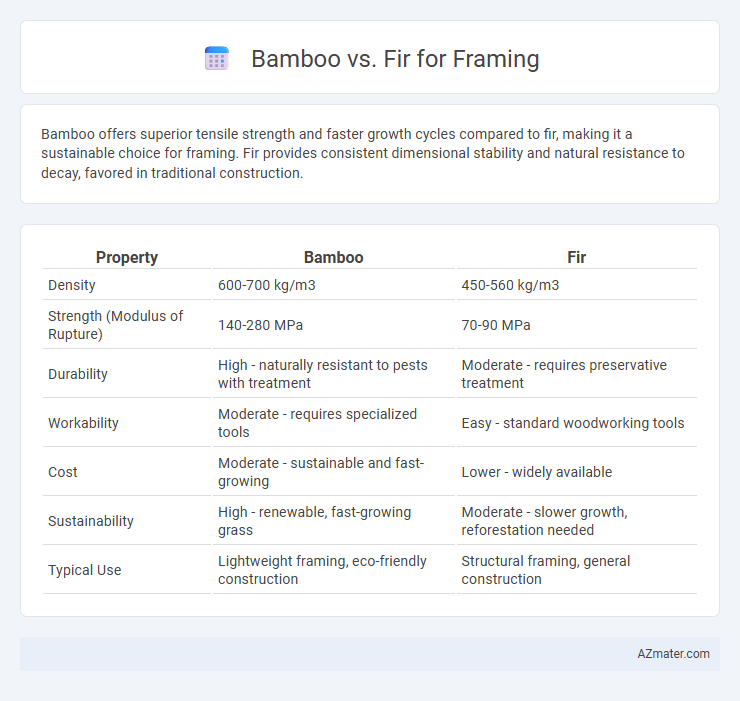Bamboo offers superior tensile strength and faster growth cycles compared to fir, making it a sustainable choice for framing. Fir provides consistent dimensional stability and natural resistance to decay, favored in traditional construction.
Table of Comparison
| Property | Bamboo | Fir |
|---|---|---|
| Density | 600-700 kg/m3 | 450-560 kg/m3 |
| Strength (Modulus of Rupture) | 140-280 MPa | 70-90 MPa |
| Durability | High - naturally resistant to pests with treatment | Moderate - requires preservative treatment |
| Workability | Moderate - requires specialized tools | Easy - standard woodworking tools |
| Cost | Moderate - sustainable and fast-growing | Lower - widely available |
| Sustainability | High - renewable, fast-growing grass | Moderate - slower growth, reforestation needed |
| Typical Use | Lightweight framing, eco-friendly construction | Structural framing, general construction |
Introduction to Bamboo and Fir as Framing Materials
Bamboo offers exceptional tensile strength and rapid renewability, making it an eco-friendly alternative for framing structures compared to traditional fir wood. Fir is a softwood prized for its uniform grain, dimensional stability, and ease of cutting, widely used in construction framing. Both materials provide unique benefits where bamboo excels in sustainability and tensile properties, while fir is valued for its consistent load-bearing capacity and workability.
Sustainability and Environmental Impact
Bamboo offers superior sustainability compared to fir due to its rapid growth rate and ability to be harvested without replanting, reducing deforestation and carbon emissions. Fir, while traditional and strong for framing, requires longer growth periods, contributing to greater habitat disruption and higher carbon footprints. Bamboo's high tensile strength and regenerative properties make it an eco-friendly alternative that supports sustainable construction practices.
Strength and Structural Integrity Comparison
Bamboo exhibits exceptional tensile strength, often surpassing traditional softwoods like fir, making it highly resilient under stress and ideal for flexible structural applications. Fir offers consistent compressive strength and dimensional stability, proving reliable for load-bearing framing in conventional construction. Choosing between bamboo and fir depends on project requirements, as bamboo excels in tensile capacity while fir maintains superior uniformity and resistance to deformation.
Cost and Availability
Bamboo offers a sustainable and cost-effective alternative to fir for framing, often priced lower due to its rapid growth and widespread availability in tropical regions. Fir, a traditional framing material, is widely available in North America and typically commands a moderate price influenced by lumber market fluctuations. Availability of bamboo may vary considerably outside Asia, potentially increasing shipping costs and impacting overall affordability compared to the more consistently accessible fir lumber.
Durability and Longevity
Bamboo offers exceptional durability due to its high tensile strength and natural resistance to pests and moisture, making it an eco-friendly option for framing with a lifespan often exceeding 50 years when properly treated. Fir, a softwood commonly used in construction, provides moderate durability but is more susceptible to rot and insect damage without chemical treatment, typically lasting 20 to 30 years in framing applications. Bamboo's rapid growth and superior resilience enhance its longevity compared to fir, which requires ongoing maintenance to prevent structural degradation.
Workability and Construction Ease
Bamboo offers superior workability for framing due to its natural flexibility and lighter weight, enabling faster handling and easier cutting compared to fir. Fir, while denser and heavier, provides consistent strength but requires more effort during nailing and sawing, impacting construction speed. The ease of construction with bamboo often results in reduced labor costs and shorter build times, making it a preferred choice in sustainable building projects where efficiency and environmental impact are prioritized.
Resistance to Pests, Mold, and Decay
Bamboo exhibits superior resistance to pests, mold, and decay due to its natural silica content and rapid growth cycle, making it a durable choice for framing. Fir, while commonly used in construction, is more susceptible to insect infestation and fungal growth without proper treatment, requiring sealants or preservatives to enhance longevity. The inherent strength and natural protective properties of bamboo contribute to lower maintenance and better durability in environments prone to moisture and biological threats.
Insulation and Thermal Properties
Bamboo exhibits superior insulation and thermal properties compared to fir, with a lower thermal conductivity rate, making it more effective at reducing heat transfer in framing applications. Fir wood, while structurally reliable, has a higher thermal conductivity, which results in less efficient thermal insulation. Using bamboo in framing not only enhances energy efficiency but also contributes to sustainable building practices due to its rapid growth and renewability.
Aesthetic Differences
Bamboo framing offers a unique, organic aesthetic characterized by its natural nodes and smooth, glossy surface, creating a warm, tropical ambiance ideal for eco-friendly designs. Fir framing presents a more traditional appearance with a straight grain, uniform texture, and pale reddish-brown hue, providing a classic, timeless look suitable for conventional architecture. The choice between bamboo and fir significantly impacts the visual appeal and style of the framed structure, influencing both modern and rustic design preferences.
Conclusion: Choosing the Right Material for Your Project
Bamboo offers superior sustainability and rapid growth compared to fir, making it an eco-friendly choice for framing with excellent tensile strength. Fir provides traditional reliability, ease of workability, and consistent availability, suitable for conventional construction methods. Selecting between bamboo and fir depends on project priorities such as environmental impact, structural requirements, and regional material accessibility.

Infographic: Bamboo vs Fir for Framing
 azmater.com
azmater.com